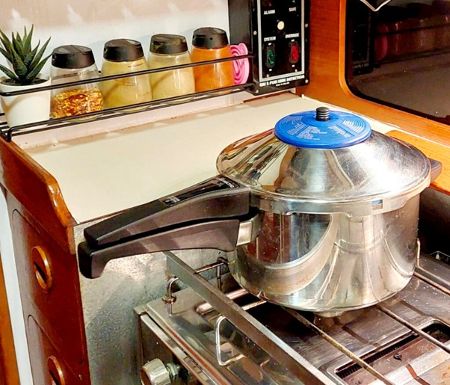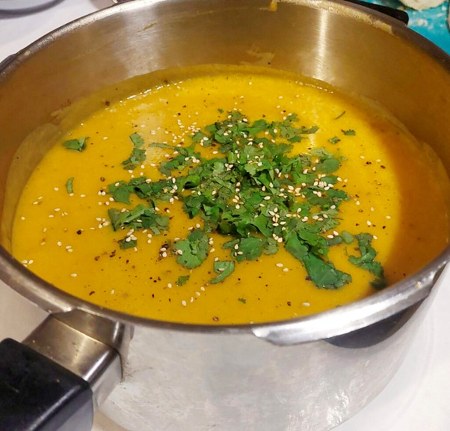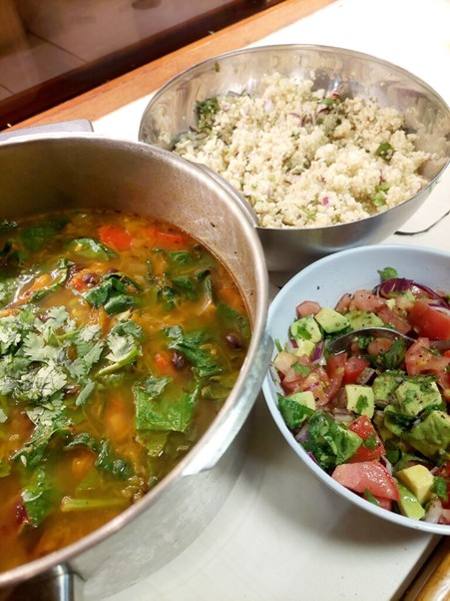INSIGHTS: How a Pressure Cooker Can Save the Galley Game
After leaving her pressure cooker in storage for two years, live-aboard cruiser Sarah Powell finally plucked up the courage to actually use it. In this article for Noonsite, Sarah explains why this is now one of her “must-have” items in the galley.
Published 1 year ago
Revolutionizing cooking on a boat
I am often asked what galley equipment is necessary when you set up for a life on the water. Whilst the answer to this question largely depends on how much space you have and what kind of meals you like to prepare, I am going to take my love for the pressure cooker to the next level and say that this particular piece of galley equipment is one of those “must-have” items.
I say so with a sheepish smile because I had mine for two whole years before I plucked up the courage to actually use it. Yes, you read that right, and my extensive research of the item in question reassured me that I was not alone. Far from it. You see, it seems that the pressure cooker sits on the extremes. You either use it and love it, or you don´t and fear it. For way too long I feared mine.
When I eventually blew the cobwebs off it, I discovered the game-changing possibilities of the pressure cooker. In this article I share with you my personal experience and insights of an often misunderstood and totally undervalued piece of galley equipment.
I use my pressure cooker almost daily, and it has marked a turning point in my culinary adventures at sea. The compact design and versatility of this slightly retro cooking apparatus immediately appealed to the constraints of boat life.
So, what is a pressure cooker?
There are two main types that you can find on the market today, a traditional stove-top pressure cooker and the newer electric pressure cookers or instapots as they are often called. They work in fundamentally the same way, using a build-up of steam pressure to raise the temperature above boiling point and force liquid into ingredients, which reduces the time needed to cook the food.
Given that not every boat has the electrical capabilities to use an instapot (especially mine!) I refer to the stove-top pressure cooker in this article.



Why is it such a good item to have on board?
A good quality pressure cooker has many advantages on a boat.
One of the first lessons I learned when I eventually plucked up the courage to use mine, was the incredible time efficiency of pressure cooking. Whether at sea or at anchor this stainless-steel pan became my ally in whipping up quick, nutritious and delicious one-pot wonders among other dishes. It also ticks all the boxes that I look for when justifying a galley equipment addition.
1. Safe for use at sea
Cooking during rough seas tested both my sailing and culinary skills. Adjusting cooking times and carefully monitoring the pressure cooker ensured that even in challenging conditions, I could deliver a hot and comforting meal. Thanks to its sealed lid system, there are no spillages or flying lids!
A sealed lid is a bonus safety feature when seas are building.
I have not found any reliable exploding pressure cooker articles and, in the knowledge that today’s models have built-in safety features with locked lids and pressure valve to release steam if the pressure gets too high, I certainly feel assured while I am cooking. That said, it is essential to follow safety guidelines when using a pressure cooker. Ensure that the cooker is properly sealed, release pressure cautiously, and never open the cooker until it is safe to do so.



2. Low energy consumption
Pressure cookers cook food faster than traditional methods by trapping steam and increasing pressure. Kuhn Rikon (a Swiss pressure cooker brand, which happens to be the one I use – no paid link) state that cooking with a pressure cooker uses 70% less energy. This can be particularly useful on the boat where we are always trying to be mindful of the energy we consume and especially in more remote areas where cooking gas is harder to source.
3. Time saving
Given how the pressure cooker works it can cook pasta or rice in five minutes, soaked chickpeas and beans in 15- 20 minutes, plant-based stews, and curries in five minutes. For those who cook meat, it also means you can enjoy those recipes that call for long hours in the oven or slow cooker using minimal gas.
The added advantage of using a pressure cooker on passage is that I know that I don´t have to be downstairs for any length of time keeping my eye on the stove. Once it has reached the desired cooking time, I can switch of the gas and leave the pressure to release naturally. In a hot and humid anchorage, I can cook ingredients relatively quickly without heating up the cabin (and myself!).
4. Low water consumption
When using a pressure cooker you are limited to the amount of water that you can put in the pan as it should never be filled more than two thirds full. Given the nature of how food is cooked in the pressure cooker there is always liquid which makes it easier to empty and cleaning can be done with a quick wash and rinse if making plant-based foods. If cooking meats, then you will need to use more water and detergent to get rid of the grease.
5. Low maintenance
Most modern pressure cookers are made from stainless steel, this makes them durable and easy to clean. Rinsing the pressure cooker with freshwater and conducting routine maintenance ensures its longevity, preventing the corrosive effects of salt air.
6. Preserves nutrients
The reduced cooking time in a pressure cooker helps in preserving the nutritional content of the food better than other methods that may involve prolonged cooking. It is great for steaming vegetables too, which really helps lock in those valuable nutrients. I believe this is a big advantage of cooking with a pressure cooker and am not the only one.
The New York Times bestselling author, physician, and internationally recognized speaker on nutrition. Dr. Michael Greger states the following: “Researchers have found that pressure-cooked beans have six times the antioxidant levels of boiled (pre-soaked) black beans.”
When the Researchers looked at a variety of methods—e.g., 12 minutes of boiling, five minutes of pressure cooking and six minutes of microwaving carrots—they found that cooking increased their antioxidant potential and pressure cooking nearly doubled their antioxidant value.
As I am dedicated to ensuring my family and clients get optimal nutrition to support the active water-based lifestyle, it is no brainer for me to cook as much as I can with the pressure cooker.


What should you look for when purchasing a pressure cooker?
So, if you like what you have read so far and think a Pressure Cooker is the perfect addition to your galley, here is a quick list of things to bear in mind when purchasing one.
1. Choose high quality
For this kind of item, quality and safety go hand-in-hand, but equally that doesn´t mean that you have to spend a lot of money. I suggest buying one from a reputable brand as this item is built to last and you should get decades of use out of it.
2. Stainless is best
I recommend buying a stainless steel one as they are easy to clean, and low maintenance. Stainless steel is non-reactive to acidic and salty food items, making pressure cookers made of stainless steel a healthier choice. Given that stainless steel conducts heat slowly, it makes it less likely to burn food which is both helpful and motivating if you are new to cooking with a pressure cooker.
3. Two handles are better than one
Make sure the pressure cooker you purchase has two handles. It makes it so much easier to lift and carry the pan especially whilst on passage.
4. Size is important
In this case, the smaller you can go for the better. Not only will your cooker have to fit neatly on your galley stove, but you also must be able to lift it comfortably when the boat is moving.


My Pressure Cooker is 7 Litres (7.3 quarts) and 22cm (8.6 inch) diameter. It is great for the three of us and is enough for two meals. It sits well on the galley stove and there is an even coverage of heat – which is also an important part of using the pressure cooker correctly.
Savings, safety and nutrition
In my opinion, it makes complete sense to have a pressure cooker onboard. Saving time and energy, it also offers a safe way to cook whilst sailing with the added bonus of knowing you will be getting the very best nutrition from the ingredients you cook.
If you are thinking of getting a pressure cooker, blowing off the cobwebs of your underused pan or just interested in some new recipes, then keep an eye out for my forthcoming articles detailing my favorite pressure cooker recipes.
Do you have one onboard? If so, I would love to know your how you find using the pressure cooker. Is it an essential item in your galley? If you don´t yet have one, are you interested in buying one?
Fair winds and bon appétit!
Sarah Powell
…………………………………
Read Sarah’s Other INSIGHT articles for Noonsite:
…………………………………
Read more INSIGHTful articles on Noonsite
…………………………………
About the Author:
Sarah Powell is a full-time live-aboard cruiser currently based in Lanzarote for the forthcoming year. She passionately believes in provisioning and preparing nourishing, nutrient-rich, mood-enhancing foods to support the active and emotional adventure of living at sea and crossing an ocean.

All of the recipes and knowledge that she has learnt over the years, come from the experience gained in the galley of her previous Halmatic 30 and current Sigma 41.
Through seminars and workshops she shares, with cruisers and sailors, how it is possible to prepare delicious nutrient-dense food in the smallest of kitchens, with minimal equipment from wherever you are sailing around the world. You can read more about Sarah at:
- Website: www.smallvegankitchen.com
- Linkedin: https://www.linkedin.com/in/sarahpowellfowler
- Instagram: www.instagram.com/smallvegankitchen.com
- Facebook: www.facebook.com/smallvegankitchen
…………………………………
The opinions expressed in this article are the author’s own and do not reflect the view of Noonsite.com or World Cruising.
…………………………………
Find out all news, reports, links and comments posted on Noonsite, plus cruising information from around the world, by subscribing to our FREE monthly newsletter. Go to https://www.noonsite.com/newsletter/.
Related to the following Cruising Resources: Insights, Liveaboard Tips, Planning and Preparation



